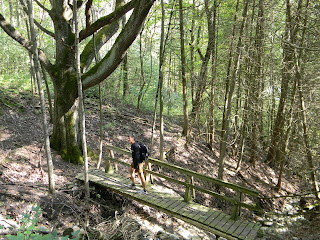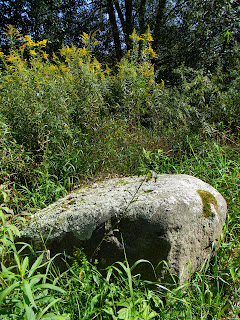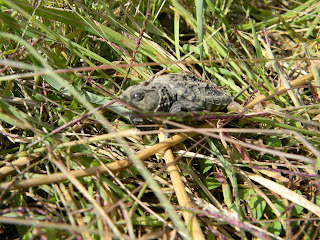Date of hike: Sun. Sept. 18, 2011 Weather: 15C, sunny; 20C at completion
Section: 14Duration of hike (including a brief lunch stop part-way): 5 hours Distance: 16.6 km
Cumulative distance: 41.1 km With the goal of trying to be on the portion of the trail that passes through London by the time the snow flies, we had made a plan of what legs we needed to do and when we might do them. This leg of the trail was our longest one to date and would require a significant amount of time. We could’ve broken it up into two smaller legs, but that would mean another Saturday or Sunday afternoon, and that just didn’t work out in our timeline. So, off we set, one bright and sunny Sunday morning, with lunch and snacks packed, to tackle this 10+ mile section.
With the goal of trying to be on the portion of the trail that passes through London by the time the snow flies, we had made a plan of what legs we needed to do and when we might do them. This leg of the trail was our longest one to date and would require a significant amount of time. We could’ve broken it up into two smaller legs, but that would mean another Saturday or Sunday afternoon, and that just didn’t work out in our timeline. So, off we set, one bright and sunny Sunday morning, with lunch and snacks packed, to tackle this 10+ mile section.Like the previous two legs, this section offered its own unique aspects as will be detailed. We chose to make our start/finish point of the last hike the turn-around point, as this allowed us to read the trail description in the forward direction rather than the reverse direction. The terrain was varied; from steep hillside ravines to low-lying flat flood plains. The air was brisk and had an autumn-like quality to it and we definitely saw the season beginning to turn.
We parked the car just off of Plover Mills Road and headed out along the edge of a farm pasture under the curious eyes of some grazing cattle. The trail soon went into the woods and alternated back out into open grassy areas. As we made our way, the trail started to traverse along steeper hillsides with ravines cutting through. Every one of these ravines had a bridge crossing it, so that made it easy to get across. Likewise, in the low-lying grassy areas, several boardwalks kept us up and over the wet marshy ground. In all, we counted a total of 16 bridges and/or boardwalks that were in place for the hiker’s convenience and all thanks to one generous donor who had provided the materials for their construction.
While the trees weren’t giving much indication with regards to the looming approach of fall, there were other signs that were apparent. The brilliant glow of the goldenrod with the contrast of the majestic purple of the wild asters was out in full force. Some late blooming black-eyed Susan along with these tall stalked yellow blooming wild flower added more colour to the trailside as well.
The trail guide advised us to watch for some large boulders that would have been deposited by the glaciers twenty-five thousand years ago. We found those as well as some even larger ones....amazing!
One particular section of the trail passed through what was obviously a floodplain, making one realize that in spite of its often bucolic demeanour, the Thames River can be a force that also demands respect.
Soon we could hear the sound of vehicles zipping along Highway 7 and we knew we were close to the turn-around. This was the first time we have had to cross the river along the trail and the bridge offered a good vantage point for some lovely views of the lazy river. We made our way across the bridge, touched the sign post of the start/finish point of the last leg, and then headed back.
 Shortly after turning around, we found a spot to sit and eat our lunch. During that brief stop, we encountered another hiker on the trail—a young woman out walking her dog—something she said that she did regularly along this section of the trail. She seemed just as surprised to see us as this does not seem to be a section of the trail that gets many passersby. So far, other than her and one other couple that we passed going the opposite direction that day, that has been the only other hikers we’ve seen.
Shortly after turning around, we found a spot to sit and eat our lunch. During that brief stop, we encountered another hiker on the trail—a young woman out walking her dog—something she said that she did regularly along this section of the trail. She seemed just as surprised to see us as this does not seem to be a section of the trail that gets many passersby. So far, other than her and one other couple that we passed going the opposite direction that day, that has been the only other hikers we’ve seen.Another visitor that we had during our break was this Praying Mantis. It seemed to have some kind of an affinity to me because no matter what I did to try and escape from it, it always found me yet again. Good thing I’m not too squeamish about things like that!
When we were almost back to the car, we came upon this little fellow, sunning himself on the trail. He was so small that we nearly stepped on him—good thing we didn’t! If you look closely enough, you can see some of the river mud still caked on him. The Thames is home to the snapping turtle species—one that is listed as a “Species of Special Concern” due to its late breeding age and survival challenges for eggs and the hatched young. It’s always a good sign of health for a river when there are turtles; hopefully this is a sign of their comeback on the river.
Before finishing off this very long trek, we checked to see where we might possibly pick up the next leg, if we decide to start from this end. I felt tired after being out for almost 5 hours, but not as tired as I was after the first leg, which was much shorter. Perhaps I’m building up my hiker’s endurance factor? At any rate, exploring the TVT to this point in time has been rewarding on many levels indeed!






















No comments:
Post a Comment